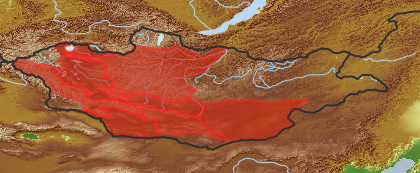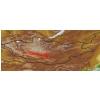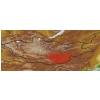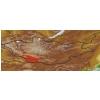| Class: | angiosperms |
| Order: | Lamiales |
| Family: | Plantaginaceae |
| Genus: | Plantago |
| Scientific name: | Plantago minuta Pall. |
| Name acc. to: | Gubanov 1996 |
| Herbar: | list records    |
| Synonym: | P. mongolica Decaisne (acc. to Flora of Chine online (20.3.2013)) |
| Description: | Small villous annual with numerous stems, 2-7 cm high. Leaves linear to linear-lanceolate, 1-7 mm wide, with entire margin. Capsule 2 seeded. |
| Link to Flora of China: | http://www.efloras.org/browse.aspx?flora_id=2&name_str=Plantago+minuta |
| open map in a new window |  |
| Habitat: | Steppe and desert debris and stony slopes and tailings, sandy-pebble river banks and shoals, bottom of sayrs, sandy steppes (Grubov 2001). |
| Habit (i)general appearance of a plant | |
| Growth form: (i)Herb, shrub, tree or climber. | annual (i)Completing its life cycle within one year or one growing season; roots weak and thin
herb (i)Herbaceous, erect plant, up to 2m high, mostly with a leafy shoot; if perennial, shoots die to the ground each season, shoots are not woody
example: Artemisia pectinata   inherited by family Plantaginaceae: herb inherited by family Plantaginaceae: herb
acc. to: FoC online |
| Special growth forms or habits: | rosette plant (i)All or nearly all leaves in a basal rosette, only inflorescences on erect stalks, these without or with much smaller leaves
example: Primula farinosa   inherited by family Plantaginaceae: rosette plant inherited by family Plantaginaceae: rosette plant
|
| Parasite status: (i)Is the plant a half- or full parasite? | no parasite/saprophyte (i)Plant fully autonomous, leaves with chlorophyll
example: Most plants, Ranunculus  inherited by family Plantaginaceae: no parasite/saprophyte inherited by family Plantaginaceae: no parasite/saprophyte
|
| Water or terrestrial plant: (i)Where do the plants grow? | terrestrial (i)Plant grows on dry land
example: Orostachys spinosa  inherited by family Plantaginaceae: terrestrial inherited by family Plantaginaceae: terrestrial
|
| Leaf (i)expanded, usually photosynthetic organ of a plant (including phylloclades) | |
| Leaf arrangement: (i)Arrangement of leaves at the stem. | basal rosette (i)Leaves positioned at the base of the stem; stem often without leaves, no visible internodes (but flowers often on erect stems, and these may have few leaves)
example: Limonium, Potentilla, Plantago; also used in Liliales with basaly crouwded leaves (Tofieldia, Zigadenus etc.)   inherited by family Plantaginaceae: basal rosette inherited by family Plantaginaceae: basal rosette
|
| Simple or divided leaves: (i)Are the leaves simple or completely divided in several parts? Blade of the leaf entire or (more or less) deeply dissected. Attention: There are various appearances of the leaf margin (from entire to toothed and lobed). Here, we ignore this and ask only for dissections that separate the leaf for more than one third of its length or width, whatever is smaller. Sometimes, it is difficult to tell apart compound leaves from a shoot system with simple leaves: look for stipulae and/or axillary buds at the ground of the leaves: if only some possess these structures, the others are most likely leaflets of a compound leaf. | simple (i)Non-divided leaf, but margin may be incised nearly to the ground   inherited by family Plantaginaceae: simple inherited by family Plantaginaceae: simple  inherited by genus Plantago: simple inherited by genus Plantago: simple
|
| Shape of blade: (i)Easy for simple leaves. In compound leaves use the general shape of leaflet. Always check the ground for largest leaves of a plant. To be worked out: how to handle pinnate leaves? | elliptic (including ovate and obovate) (i)Elliptic: broadest at the middle and narrower at the two equal ends; ovate: egg-shaped, attached at the broad end; obovate: attached at the narrower end
example: Limosella aquatica   inherited by family Plantaginaceae: elliptic (including ovate and obovate) inherited by family Plantaginaceae: elliptic (including ovate and obovate)
|
| Leaf apex: (i)Appearance of the tip of leaf resp. leaflets in compound leaves. | rounded (i)With a round apex
example: Trifolium 
obtuse (i)Sides coming together at the apex at an angle greater than 90 degrees
example: Fallopia convolvulus   inherited by family Plantaginaceae: obtuse inherited by family Plantaginaceae: obtuse
acuminate (i)Gradually tapering to a (sharp) point
example: Populus laurifolia?   inherited by family Plantaginaceae: acuminate inherited by family Plantaginaceae: acuminate
|
| Leaf margin: (i)Structure of leaf margin (or that of a leaflet in case of compound leaves). Attention: Here we ask for the leaf margin, defined as all those dissections that separate the leaf for less than one third of its length or width, whatever is smaller. To be worked out: how to handle margin of pinnate leaves? | serrate / dentate / crenulate (i)Margin saw-like or rounded teethed
example: Betula, Lophanthus (crenulate)   inherited by family Plantaginaceae: serrate / dentate / crenulate inherited by family Plantaginaceae: serrate / dentate / crenulate
finely serrate / dentate (i)Fine teeth, more than 20 per leaf length; usually only one lateral vein per tooth
example: Pedicularis   inherited by family Plantaginaceae: finely serrate / dentate inherited by family Plantaginaceae: finely serrate / dentate
entire (i)Plain margin, not toothed
example: Iris   inherited by family Plantaginaceae: entire inherited by family Plantaginaceae: entire
|
| Stipule: (i)Leaflets at the base of the petiole, these are smaller and of different shape. | none (i)Without stipules
example: Euphorbia, Ericaceae s.l.  inherited by family Plantaginaceae: none inherited by family Plantaginaceae: none
|
| Leaf colour upper side: (i)Shades of green on the leaf, upper side. | grayish (i)Grayish in colour due to hairs or a thick cuticula
|
| Leaf colour lower side: (i)Shades of green on the leaf, lower side. | grayish (i)Grayish in colour due to hairs or a thick cuticula
example: Atriplex cana
|
| Leaf veination: (i)Arrangement of the main veins of a leaf. | parallel (i)Most veins arranged parallel to the length of leaf, mostly no pronounced main vein (usually in elongate to linear leaves)
example: Most Monocotyledonae, Plantago, Veratrum, a lot of Caryophyllaceae looks like that.   inherited by family Plantaginaceae: parallel inherited by family Plantaginaceae: parallel  inherited by genus Plantago: parallel inherited by genus Plantago: parallel
|
| Flower (i)reproductive portion of the plant, consisting of sepals, petals, stamens, and pistils | |
| Flower appearance and pollination: (i)General appearance of the flower. | not attractive, wind-pollinated or some water plants (i)Small, colourless or green flowers
example: Betula, grasslike plants: Carex, Setaria, Juncus  inherited by family Plantaginaceae: not attractive, wind-pollinated or some water plants inherited by family Plantaginaceae: not attractive, wind-pollinated or some water plants
|
| Flower colour: (i)Attention: assess colour of the most colourful parts of the flower, but not of the stamens; be aware of single plants with a mutation (mostly white) on flower colour. | greenish (i)petals absent or not distinctly different from colours of leaves, only stigmas (white) or anthers (yellow) may differ in color
example: Chenopodium, Triglochin
white (i)Most plants of the population white
example: Pleurospermum, Maianthemum
|
| Perianth arrangement: (i)Attention: in some plants, flowers may be dimorphic in different ways (dioecious or gynodioecious). If flowers vary, record the characters of the most showy flowers. | double, different (i)Two types of perianth leaves, differently coloured (sepals: outer periant leaves, usually greenish, and petals: inner perianth leaves, usually coloured)
example: Parnassia    inherited by family Plantaginaceae: double, different inherited by family Plantaginaceae: double, different
|
| Diameter of flower: (i)Diameter of flower or flower head. | to 5 mm (i)
example: Aruncus  inherited by family Plantaginaceae: inherited by family Plantaginaceae:  inherited by genus Plantago: inherited by genus Plantago:
from 5 mm to 10 mm (i)
example: Stellaria  inherited by family Plantaginaceae: inherited by family Plantaginaceae:  inherited by genus Plantago: inherited by genus Plantago:
|
| Flower symmetry: (i)Symmetry of the perianth leaves. Attention: to assess this character, look on sepals, petals and stamens, but neglect carpels and ovary. | radiary, regular (actinomorphic) (i)More than two axis of symmetry
example: Saxifraga: 5; Iris: 3   inherited by family Plantaginaceae: radiary, regular (actinomorphic) inherited by family Plantaginaceae: radiary, regular (actinomorphic)
|
| Flower form: (i)common forms of flowers ? Veronica | tubular to funnel-shaped (i)Petals form a tube, are often partially united to a cylindrical corolla, often surrounded by a calyx   inherited by family Plantaginaceae: tubular to funnel-shaped inherited by family Plantaginaceae: tubular to funnel-shaped
|
| Sepal number: (i)Number of sepal leaves (outer perianth leaves, calyx leaves, mostly greenish). Attention, this character applies only for flowers separated in sepals and petals, thus excluding most monocots. Be aware of the bracts (involucral leaves) of Asteraceae flowerheads, do not qualify these as sepals! Be also aware in Rosaceae is often an epicalyx developed, in this case count all parts. | 4 (i)
example: Sinapis  inherited by family Plantaginaceae: 4 inherited by family Plantaginaceae: 4
|
| Sepal fusion: (i)To which degree are the sepal leaves connected? Attention, this character applies only for flowers separated in sepals and petals, thus excluding most monocots. Be aware of the bracts (involucral leaves) of Asteraceae flowerheads, do not qualify these as sepals! | free (i)All leaves separate from each other
example: Geranium  inherited by family Plantaginaceae: free inherited by family Plantaginaceae: free  inherited by genus Plantago: free inherited by genus Plantago: free
|
| Petal / Tepal number: (i)Number of petal leaves (inner perianth leaves, usually coloured). | 4 (i)
example: Galium  inherited by family Plantaginaceae: 4 inherited by family Plantaginaceae: 4  inherited by genus Plantago: 4 inherited by genus Plantago: 4
|
| Petal / Tepal fusion: (i)To which degree are the petal leaves connected? Petals sympetalous. | fused at base (i)petal leaves with a joint base, but fused over not more than 50% of the entire length
example: Myosotis, Pedicularis, Cortusa  inherited by family Plantaginaceae: fused at base inherited by family Plantaginaceae: fused at base
fused (i)petal leaves united, only tips are free (gamopetalous, sympetalous)
example: Linnaea, Adenophora, Stellera  inherited by genus Plantago: fused inherited by genus Plantago: fused
|
| Spur: (i)A hollow, slender, sac-like appendage of the perianth leaves, storing nectar. | no spur (i)Flower without appendage
example: Peganum  inherited by family Plantaginaceae: no spur inherited by family Plantaginaceae: no spur
|
| Stamen number: (i)Attention: We ask for the reproductive organs of the flower dispersing pollen. Count only fully fertile stamens, not staminodia (e.g. Parnassia). | 4 (i)Extremely rare, may be absent
example: Plantago  inherited by family Plantaginaceae: 4 inherited by family Plantaginaceae: 4
|
| Stamen fusion: (i)To which degree are the stamens fused? Attention: Whereas the pollen sacs itself are often free., their stalks (filaments) may be fused. Here, we count them as fused if they are together over at least one thirth of their length. | free (i)Stamens with separate bases
example: Malus  inherited by family Plantaginaceae: free inherited by family Plantaginaceae: free  inherited by genus Plantago: free inherited by genus Plantago: free
|
| Pistil number: (i)Number of pistils (female floral organs: style, if developed; stigma and carpels/ovary together build the pistil). | 2 (i)Two stigmas, often cleaved like a snakes tongue
example: Salvia, Arnica, Bupleurum, Bromus, Saxifraga, Veronica  inherited by family Plantaginaceae: 2 inherited by family Plantaginaceae: 2
|
| Carpel fusion: (i)To which degree are the carpels (modified leaf forming simple pistil or part of a compound pistil) fused. | fused (i)Carpels united into an ovary, only styles are free
example: Malus, Berberis  inherited by family Plantaginaceae: fused inherited by family Plantaginaceae: fused
|
| Ovary position: (i)For entirely or partly fused carpels, describe their position in relation to the insertion point of perianth leaves (best done by doing a longitudinal section of a flower). | superior (hypogynous) (i)Base of carpels attached above insertion point of perianth leaves, carpels free or fused
example: Delphinium, Anemone    inherited by family Plantaginaceae: superior (hypogynous) inherited by family Plantaginaceae: superior (hypogynous)
|
| Sex: (i)Distribution of male and female organs among flowers, only most commonly cases. | bisexual, hermaphrodite (i)All or nearly all flowers of a plant with male and female parts
example: Haplophyllum, Chenopodium  inherited by genus Plantago: bisexual, hermaphrodite inherited by genus Plantago: bisexual, hermaphrodite
unisexual (i)
example: Rhodiola  inherited by family Plantaginaceae: unisexual inherited by family Plantaginaceae: unisexual
dioecious (i)Male and female flowers at different individuals
example: Antennaria  inherited by family Plantaginaceae: dioecious inherited by family Plantaginaceae: dioecious
|
| Inflorescence (i)flowering part of a plant, describes the arrangement of the flowers on the flowering axis | |
| Inflorescence: (i)Structure of the inflorescence. | Flowers in inflorescence (i)No solitary flowers  inherited by family Plantaginaceae: Flowers in inflorescence inherited by family Plantaginaceae: Flowers in inflorescence
Simple inflorescences (i)Flowers sessile on a main shoot or on short to long not branched side shoots
example: Polygonum bistorta    inherited by family Plantaginaceae: Simple inflorescences inherited by family Plantaginaceae: Simple inflorescences
|
| Appearance: (i)Outer look of the inflorescence. | terminal (i)Inflorescence is the highest point of the plant and may consist of a single flower only
example: Cypripedium, Rhaponticum, Ligularia sibirica, Echinops  inherited by family Plantaginaceae: terminal inherited by family Plantaginaceae: terminal  inherited by genus Plantago: terminal inherited by genus Plantago: terminal
|
| Inflorescence type: (i)Types of inflorescence. Attention: We here ask for the botanical nomenclature of inflorescences, which is sufficiently complicated. Tick only, if you are certain, or tick all inflorescence types that appear similar of these of the plant in question. | spike (spadix) (i)All flowers sessile and crowded along a main axis, there may be several spikes on a shoot; sometimes axis thickened (spadix)
example: Plantago, Carex vesicaria, Vicia, Typha (spadix)    inherited by family Plantaginaceae: spike (spadix) inherited by family Plantaginaceae: spike (spadix)
|
| Fruit (i)the seed bearing organ, with or without adnate parts; a ripened ovary and any other structures which are attached and ripen with it. Aggregate fruits are handled like simple fruits for determination. | |
| Consistency: (i)Fleshy fruits or dry fruits, see dispersal adaptations for further classification. | dry (i)With a dry outer shell, no fleshy parts, but seed (embryo) could be edible  inherited by family Plantaginaceae: dry inherited by family Plantaginaceae: dry  inherited by genus Plantago: dry inherited by genus Plantago: dry
|
| Type of fruit: (i)Common fruit types (including pseudocarp). | Solitary fruits (i)     inherited by family Plantaginaceae: Solitary fruits inherited by family Plantaginaceae: Solitary fruits
capsule (i)Dry dehiscent fruit, releasing seeds by slits or holes.
example: Poppy, most Caryophyllaceae, Cerastium, a lot of Scrophulariaceae, Iris (oppened capsule looks like Delphinium), Zygophyllum - it is a very common fruit type     inherited by family Plantaginaceae: capsule inherited by family Plantaginaceae: capsule
Dehiscent fruits (i)Fruits open along a longitudinale line (except silicula)  inherited by family Plantaginaceae: Dehiscent fruits inherited by family Plantaginaceae: Dehiscent fruits
|
| Opening of fruit: (i)Mode of dehiscence at maturity to release seeds. | opening / dehiscent (i)Dry? Fruits opening with different types  inherited by family Plantaginaceae: opening / dehiscent inherited by family Plantaginaceae: opening / dehiscent  inherited by genus Plantago: opening / dehiscent inherited by genus Plantago: opening / dehiscent
opening with lid (i)The seed capsule opens with a small cap or cover
example: Plantago, Hyoscyamus, Anagallis (but not in Mongolia)   inherited by family Plantaginaceae: opening with lid inherited by family Plantaginaceae: opening with lid  inherited by genus Plantago: opening with lid inherited by genus Plantago: opening with lid
|
| Size of fruit: (i)Size of the fruit including appendage. | to 5 mm (i)
example: Halerpestes: many folicles forming dry nutlets  inherited by family Plantaginaceae: inherited by family Plantaginaceae:  inherited by genus Plantago: inherited by genus Plantago:
from 5 mm to 10 mm (i)
example: Silene: small capsule opening with teeth  inherited by family Plantaginaceae: inherited by family Plantaginaceae:  inherited by genus Plantago: inherited by genus Plantago:
|
| Dispersal: (i)Appearance of fruit or seed (if single) and adaptations to dispersal. | Otherwise (i)All parts dry, no conspicuous adaptations  inherited by genus Plantago: Otherwise inherited by genus Plantago: Otherwise
|
| Seed number: (i)Estimate the number of seeds per fruit, if recognizable seeds are in the fruit (in rare cases a fruit may contain one seeded nuts: rose hip, carex). | 2-6 (i)2-6 single seeds, well recognizable
example: Crataegus: few-seeded berry  inherited by family Plantaginaceae: 2-6 inherited by family Plantaginaceae: 2-6
7-50 (i)Numerable, but may be counted
example: Vaccinum: multi-seeded berry, Ptilotrichum: few-seeded siliqua  inherited by family Plantaginaceae: 7-50 inherited by family Plantaginaceae: 7-50
|
| Hairs | |
| Has hairs?: | has hairs
|
| Hairs: (i)Appearance, structure, coverage of hairs on plant. | on leaf (i)Hairs on upper side, lower side or on margin of leaf
coverage: villose (i)Hairs like a fur covering most of the surface
example: ??
leaf upper side (i)Has hairs on leaves upper side (blade)
coverage: villose (i)hairs like a fur covering most of the surface
appearance: soft (i)Hairs very flexible and soft, lay down at a touch
example: Lonicera xylosteum
appearance: soft (i)Hairs very flexible and soft, lay down at a touch
example: Rubus
structure: simple (i)Not branched
leaf lower side
structure: simple (i)Not branched
example: Chelidonium majus
|
| Shoot/Stem (i)a young stem or branch | |
| Spines, thorns or prickles: (i)Shoot with conspicuous spines, thorns or prickles. | absent (i)Stem glabrous or hairy, but never with spines, thornes or prickles
example: Gentiana barbata  inherited by family Plantaginaceae: absent inherited by family Plantaginaceae: absent
|
| Root / shoot below ground (i)plant part below ground (in most cases), including below ground shoots, without leaves | |
| Root type: (i)Organisation of the roots. | allorhizous (i)Plant with a conspicuous tap root, one larger tap root with side roots
example: Dicotyledonae  inherited by order Lamiales: allorhizous inherited by order Lamiales: allorhizous
|
| Distribution (i)region where the plant is likely to be found | |
| Distribution (Veg. Zones): (i)acc. to Grubov 1952 | Khangai (i)In distribution data often named as '3' 
Mongolian Altai (i)In distribution data often named as '7' 
Depression of Great Lakes (i)In distribution data often named as '10' 
Valley of Lakes (i)In distribution data often named as '11' 
East Gobi (i)In distribution data often named as '12' 
Gobi-Altai (i)In distribution data often named as '13' 
Transaltai Gobi (i)In distribution data often named as '15' 
acc. to: Gubanov 1996 |
| Distribution Khangay: (i)acc. Flora Khangaya 1989 | VI
|